The global packaging films market is valued at USD 155.8 billion in 2025 and is projected to reach USD 266.1 billion by 2035, recording an absolute increase of USD 111.6 billion. The demand for packaging films shows total growth of 71.6% over the forecast period, supported by a CAGR of 5.5%. The market size is expected to grow by nearly 1.7 times, reflecting consistent demand across food, beverages, personal care, healthcare, and industrial packaging.
Food and beverage applications remain the largest share contributors, driven by rising demand for flexible packaging formats that offer extended shelf life, barrier protection, and lightweight distribution benefits. Growth in e-commerce packaging, including mailers and pouches, adds momentum to the sector. Healthcare packaging is also expanding its share, supported by sterile medical supplies and pharmaceutical films designed for product integrity and regulatory compliance. Personal care and household goods provide additional growth opportunities through resealable pouches, stand-up bags, and unit dose packaging formats.
Regionally, Asia Pacific is anticipated to dominate the global share, with rapid industrialization and large-scale food processing capacity creating consistent consumption. China and India remain central demand hubs, driven by packaged food penetration and growth in organized retail. North America and Europe maintain steady contributions, reflecting mature markets but stronger uptake of recyclable and high-barrier films tailored for compliance with evolving waste management regulations. Latin America and the Middle East contribute incremental gains, with growing packaged food adoption and rising imports of advanced multilayer films.
Between 2025 and 2030, the packaging films market is projected to expand from USD 155.8 billion to USD 200.4 billion, resulting in a value increase of USD 44.6 billion, which represents 39.9% of the total forecast growth for the decade. This phase of development will be shaped by increasing demand for barrier protection mechanisms, rising consumer preference for convenient packaging formats, and growing availability of high-performance film solutions across industrial packaging operations and specialty application requirements. Between 2030 and 2035, the market is forecast to grow from USD 200.4 billion to USD 266.1 billion, adding another USD 67.0 billion, which constitutes 60.1% of the overall ten-year expansion. This period is expected to be characterized by the advancement of bio-based film technologies, the integration of smart packaging features for enhanced functionality, and the development of ultra-thin film solutions across diverse product categories. The growing emphasis on product protection and shelf-life extension will drive demand for advanced film varieties with enhanced barrier properties, improved mechanical strength characteristics, and superior processability features.
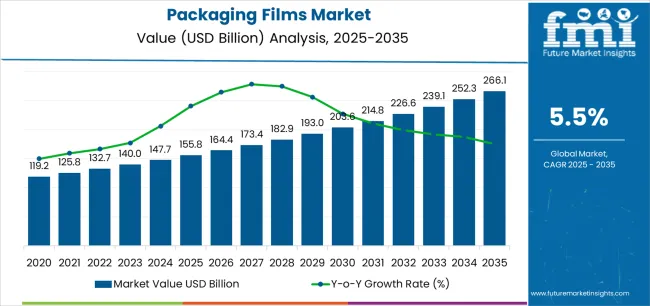
| Metric | Value |
|---|---|
| Estimated Market Value (2025E) | USD 155.8 Billion |
| Forecast Market Value (2035F) | USD 266.1 Billion |
| Forecast CAGR (2025–2035) | 5.5% |
The flexible packaging market is the largest contributor, accounting for approximately 40–45%, as packaging films play a pivotal role in the production of pouches, bags, and wraps used across food, beverages, and consumer goods. These films offer advantages like durability, cost-effectiveness, and ease of use, which are essential in flexible packaging solutions. The food and beverage packaging market contributes around 25–30%, driven by the growing need for films that can extend shelf life, enhance product safety, and offer high-quality graphics for branding.
The pharmaceutical packaging market accounts for approximately 10–12%, as films are essential in protecting medications, ensuring tamper resistance, and providing easy-to-read product information. With the increasing demand for over-the-counter drugs and prescription packaging, packaging films are crucial in ensuring compliance with regulatory standards. The consumer goods packaging market adds about 8–10%, where packaging films are used for packaging personal care items, household products, and cosmetics, driven by the need for lightweight, aesthetically appealing, and protective packaging solutions. The industrial packaging market contributes approximately 7–8%, with films being used for protecting industrial products during transit and storage, especially in sectors like electronics, machinery, and chemicals.
Market expansion is being supported by the increasing global demand for lightweight packaging solutions and the corresponding shift toward flexible formats that can provide superior barrier protection while meeting user requirements for product preservation and contamination-free storage processes. Modern businesses are increasingly focused on incorporating film technologies that can enhance supply chain efficiency while satisfying demands for consistent, reliably performing materials and optimized packaging performance practices. Packaging films' proven ability to deliver excellent barrier properties, extended shelf life, and diverse application possibilities makes them essential components for food processors and quality-conscious brand owners.
The growing emphasis on convenience packaging and portion control is driving demand for high-performance packaging film systems that can support consumer-focused positioning and comprehensive functionality benefits across ready-to-eat products, snack foods, and fresh produce categories. User preference for packaging materials that combine functional excellence with processing efficiency is creating opportunities for innovative implementations in both traditional and emerging packaging applications. The rising influence of e-commerce distribution and modern logistics infrastructure is also contributing to increased adoption of packaging films that can provide damage resistance and reliable protection characteristics.
The market is segmented by product type, material, thickness, end-use application, and region. By product type, the market is divided into polyethylene films, polypropylene films, polyester films, polyvinyl chloride films, and other specialty films. Based on material, the market is categorized into conventional plastics, biodegradable materials, recyclable compounds, and specialty polymers. By thickness, the market includes less than 15 microns, 15-50 microns, 50-100 microns, and above 100 microns. By end-use application, the market encompasses food & beverage, pharmaceuticals, personal care & cosmetics, industrial packaging, and other applications. Regionally, the market is divided into North America, Europe, Asia Pacific, Latin America, Middle East & Africa, and other regions.
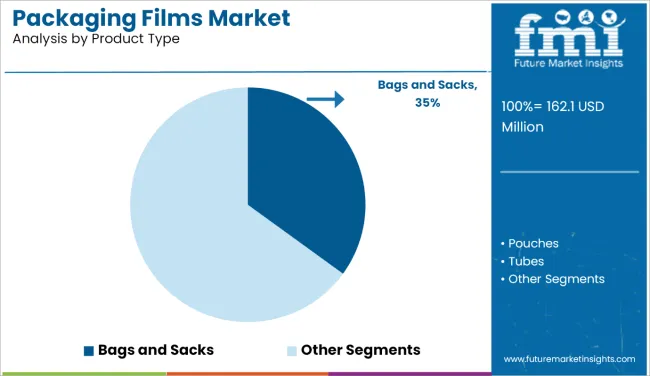
The polyethylene films segment is projected to account for 42.5% of the packaging films market in 2025, reaffirming its position as the leading product category. Businesses and packaging facilities increasingly utilize polyethylene films for their superior flexibility characteristics, established processing compatibility, and essential functionality in diverse packaging applications across multiple product categories. Polyethylene films' standardized processing characteristics and proven versatility directly address user requirements for consistent performance delivery and optimal packaging value in commercial applications.
This product segment forms the foundation of modern flexible packaging patterns, as it represents the format with the greatest processing versatility and established compatibility across multiple sealing methods. Business investments in polymer optimization and processing standardization continue to strengthen adoption among performance-conscious manufacturers. With users prioritizing cost-effectiveness and processing reliability, polyethylene films align with both functional objectives and economic requirements, making them the central component of comprehensive packaging strategies.
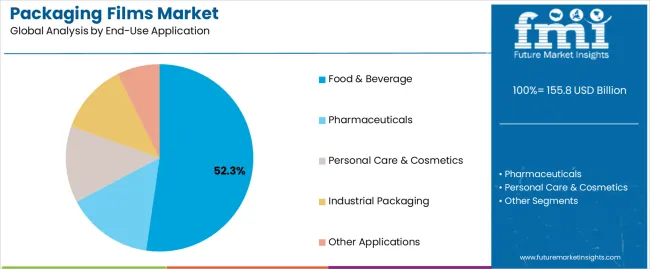
Food & beverage is projected to represent 52.3% of the packaging films market in 2025, underscoring its critical role as the primary application for quality-focused businesses seeking superior product protection benefits and enhanced shelf-life credentials. Commercial users and food processors prefer food packaging applications for their established safety positioning, proven regulatory compliance, and ability to maintain exceptional barrier profiles while supporting diverse product offerings during various storage experiences. Positioned as essential applications for discerning manufacturers, food & beverage offerings provide both product protection excellence and consumer safety advantages.
The segment is supported by continuous improvement in barrier technology and the widespread availability of FDA-approved materials that enable food safety compliance and premium positioning at the consumer level. Packaging companies are optimizing film designs to support product freshness and accessible convenience strategies. As barrier technology continues to advance and consumers seek sophisticated protection formats, food & beverage applications will continue to drive market growth while supporting brand differentiation and consumer trust strategies.
The packaging films market is advancing rapidly due to increasing demand for lightweight packaging and growing need for barrier protection mechanisms that emphasize superior product preservation outcomes across food processing segments and pharmaceutical applications. The market faces challenges, including complexity in multilayer construction, compatibility issues with certain processing equipment, and cost pressures affecting premium film adoption. Innovation in biodegradable film systems and smart packaging technologies continues to influence market development and expansion patterns.
The growing adoption of packaging film systems in e-commerce packaging is enabling businesses to develop distribution patterns that provide distinctive damage-prevention benefits while commanding consumer confidence and enhanced shipping reliability. E-commerce applications provide superior protection properties while allowing more sophisticated tamper-evident features across various product categories. Users are increasingly recognizing the functional advantages of flexible film positioning for secure product delivery and efficiency-conscious logistics integration.
Modern packaging film manufacturers are incorporating advanced multi-layer barrier technologies, nano-coating systems, and specialized additive formulations to enhance product protection, improve shelf-life performance, and meet commercial demands for extended storage capabilities. These systems improve preservation effectiveness while enabling new applications, including modified atmosphere packaging and active packaging solutions. Advanced barrier integration also allows manufacturers to support premium product positioning and quality assurance objectives beyond traditional packaging operations.
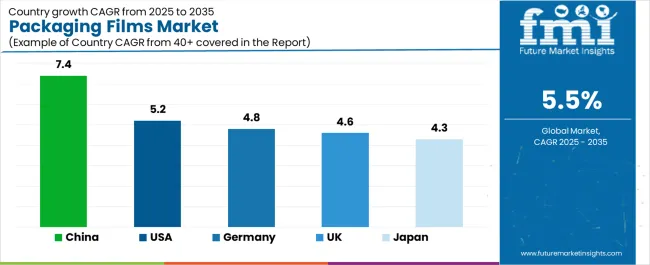
| Country | CAGR (2025–2035) |
|---|---|
| USA | 5.2% |
| Germany | 4.8% |
| UK | 4.6% |
| China | 7.4% |
| Japan | 4.3% |
The packaging films market is experiencing robust growth globally, with China leading at a 7.4% CAGR through 2035, driven by the expanding food processing industry, growing consumer goods manufacturing, and increasing adoption of flexible packaging solutions. The USA follows at 5.2%, supported by rising demand for convenience packaging, expanding e-commerce applications, and growing acceptance of advanced barrier technologies. Germany shows growth at 4.8%, emphasizing established manufacturing capabilities and comprehensive packaging innovation. The UK records 4.6%, focusing on premium food packaging and retail sophistication. Japan demonstrates 4.3% growth, prioritizing high-quality film solutions and technological precision.
The report covers an in-depth analysis of 40+ countries, with top-performing countries highlighted below.
Revenue from packaging films consumption and sales in the USA is projected to exhibit exceptional growth with a CAGR of 5.2% through 2035, driven by the country's rapidly expanding food processing sector, favorable consumer attitudes toward convenient packaging, and initiatives promoting innovative barrier technologies across major production regions. The USA's position as a leading consumer goods market and increasing focus on supply chain efficiency are creating substantial demand for high-quality packaging films in both commercial and specialty markets. Major food processors and consumer goods producers are establishing comprehensive packaging capabilities to serve growing demand and emerging market opportunities.
Demand for packaging films products in Germany is expanding at a CAGR of 4.8%, supported by rising packaging sophistication, growing industrial requirements, and expanding manufacturing infrastructure. The country's developing technical capabilities and increasing commercial investment in precision processing are driving demand for packaging films across both imported and domestically produced applications. International packaging companies and domestic manufacturers are establishing comprehensive operational networks to address growing market demand for quality packaging films and efficient barrier solutions.
Revenue from packaging films products in the UK is projected to grow at a CAGR of 4.6% through 2035, supported by the country's mature food market, established retail culture, and leadership in packaging innovation. Britain's sophisticated consumer base and strong support for premium packaging are creating steady demand for both traditional and innovative packaging film varieties. Leading food processors and specialty manufacturers are establishing comprehensive operational strategies to serve both domestic markets and growing export opportunities.
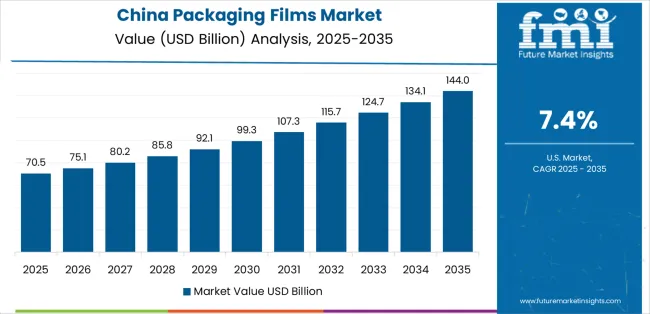
Demand for packaging films products in China is anticipated to expand at a CAGR of 7.4% through 2035, driven by the country's emphasis on food processing expansion, manufacturing leadership, and sophisticated production capabilities for materials requiring specialized barrier varieties. Chinese manufacturers and food processors consistently seek commercial-grade packaging that enhances product protection and supports supply chain operations for both traditional and innovative consumer applications. The country's position as an Asian manufacturing leader continues to drive innovation in specialty packaging film applications and commercial production standards.

Revenue from packaging films products in Japan is projected to grow at a CAGR of 4.3% through 2035, supported by the country's emphasis on quality manufacturing, packaging precision, and advanced technology integration requiring efficient barrier solutions. Japanese businesses and food processors prioritize material reliability and processing precision, making packaging films essential components for both traditional and modern product applications. The country's comprehensive quality excellence and advancing packaging patterns support continued market expansion.
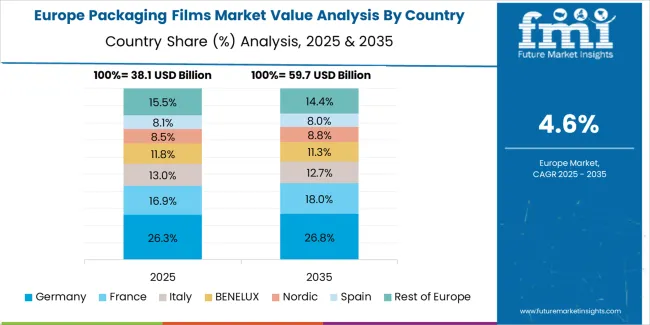
The Europe packaging films market is projected to grow from USD 48.2 billion in 2025 to USD 79.6 billion by 2035, recording a CAGR of 5.1% over the forecast period. Germany leads the region with a 32.5% share in 2025, moderating slightly to 32.0% by 2035, supported by its strong manufacturing base and demand for high-performance, technically advanced film products. The United Kingdom follows with 18.5% in 2025, easing to 18.0% by 2035, driven by a sophisticated food market and emphasis on packaging innovation and processing excellence. France accounts for 16.0% in 2025, rising to 16.5% by 2035, reflecting steady adoption of premium packaging solutions and food processing innovation. Italy holds 14.0% in 2025, expanding to 14.5% by 2035 as food processing innovation and specialty film applications grow. Spain contributes 9.5% in 2025, growing to 10.0% by 2035, supported by expanding food sector and premium product handling. The Nordic countries rise from 5.5% in 2025 to 5.8% by 2035 on the back of strong food safety adoption and advanced packaging technologies. BENELUX declines from 4.0% in 2025 to 3.2% by 2035, reflecting market maturity and regional consolidation.

The packaging films market is characterized by competition among established polymer processors, specialized film manufacturers, and integrated packaging solution companies. Companies are investing in precision extrusion technologies, advanced barrier coating systems, product innovation capabilities, and comprehensive customization networks to deliver consistent, high-quality, and reliable packaging film systems. Innovation in biodegradable materials, barrier enhancement methods, and application-specific product development is central to strengthening market position and customer satisfaction.
Amcor plc leads the market with a strong focus on flexible packaging innovation and comprehensive film solutions, offering commercial barrier systems with emphasis on processing excellence and technological heritage. Berry Global Inc. provides specialized packaging capabilities with a focus on global market applications and material engineering networks. Sealed Air Corporation delivers integrated protection solutions with a focus on barrier positioning and operational efficiency. Mondi Group specializes in comprehensive packaging manufacturing with an emphasis on commercial applications. Coveris Holdings focuses on comprehensive food and industrial films with advanced processing and premium positioning capabilities.
The success of packaging film systems in meeting commercial packaging demands, consumer-driven convenience requirements, and performance integration will not only enhance product protection outcomes but also strengthen global packaging manufacturing capabilities. It will consolidate emerging regions' positions as hubs for efficient film production and align advanced economies with commercial packaging systems. This calls for a concerted effort by all stakeholders – governments, industry bodies, manufacturers, distributors, and investors. Each can be a crucial enabler in preparing the market for its next phase of growth.
How Governments Could Spur Local Production and Adoption?
How Industry Bodies Could Support Market Development?
How Distributors and Consumer Goods Industry Players Could Strengthen the Ecosystem?
How Manufacturers Could Navigate the Shift?
| Item | Value |
|---|---|
| Quantitative Units (2025) | USD 155.8 billion |
| Product Type | Polyethylene Films; Polypropylene Films; Polyester Films; Polyvinyl Chloride Films; Other Specialty Films |
| Material | Conventional Plastics; Biodegradable Materials; Recyclable Compounds; Specialty Polymers |
| Thickness | Less than 15 microns; 15-50 microns; 50-100 microns; Above 100 microns |
| End-Use | Food & Beverage; Pharmaceuticals; Personal Care & Cosmetics; Industrial Packaging; Other Applications |
| Regions | North America; Europe; Asia Pacific; Latin America; Middle East & Africa; Other Regions |
| Key Countries | United States; Germany; United Kingdom; China; Japan; and 40+ additional countries |
| Key Companies | Amcor plc; Berry Global Inc.; Sealed Air Corporation; Mondi Group (profiled); Coveris Holdings; Other leading packaging film companies |
| Additional Attributes | Dollar sales by product type, material, thickness & end-use; Regional demand trends; Competitive landscape; Technological advancements in barrier engineering; Biodegradable technology integration initiatives; Smart packaging programs; Premium product development strategies |
The global packaging films market is estimated to be valued at USD 155.8 billion in 2025.
The market size for the packaging films market is projected to reach USD 266.1 billion by 2035.
The packaging films market is expected to grow at a 5.5% CAGR between 2025 and 2035.
The key product types in packaging films market are polyethylene films , polypropylene films, polyester films, polyvinyl chloride films and other specialty films.
In terms of end-use application, food & beverage segment to command 52.3% share in the packaging films market in 2025.






Full Research Suite comprises of:
Market outlook & trends analysis
Interviews & case studies
Strategic recommendations
Vendor profiles & capabilities analysis
5-year forecasts
8 regions and 60+ country-level data splits
Market segment data splits
12 months of continuous data updates
DELIVERED AS:
PDF EXCEL ONLINE
Market Share Distribution Among Packaging Films Suppliers
Food Packaging Films Market Size and Share Forecast Outlook 2025 to 2035
MOPP Packaging Films Market Insights - Growth & Forecast 2025 to 2035
Meat Packaging Films Market
BOPET Packaging Films Market Size and Share Forecast Outlook 2025 to 2035
Medical Packaging Films Market Size and Share Forecast Outlook 2025 to 2035
Hygiene Packaging Films Market Size and Share Forecast Outlook 2025 to 2035
Antifog Packaging Films Market Trends – Growth & Forecast 2025-2035
Compostable Packaging Films Market Size and Share Forecast Outlook 2025 to 2035
Static-Free Packaging Films Market Growth - Demand & Forecast 2025 to 2035
High Barrier Packaging Films for Pharmaceuticals Market Size and Share Forecast Outlook 2025 to 2035
High Barrier Packaging Films Market Size and Share Forecast Outlook 2025 to 2035
Competitive Landscape of High Barrier Packaging Films for Pharmaceuticals
Market Share Breakdown of High Barrier Packaging Films Suppliers
Blown Stretch Packaging Films Market Size and Share Forecast Outlook 2025 to 2035
Polypropylene Packaging Films Market Trends - Growth & Forecast 2025 to 2035
Japan Polypropylene Packaging Films Market Size and Share Forecast Outlook 2025 to 2035
Nylon Films for Liquid Packaging Market from 2024 to 2034
Micro Perforated Films Packaging Market Size and Share Forecast Outlook 2025 to 2035
Market Share Breakdown of Micro Perforated Films Packaging Manufacturers

Thank you!
You will receive an email from our Business Development Manager. Please be sure to check your SPAM/JUNK folder too.
Chat With
MaRIA